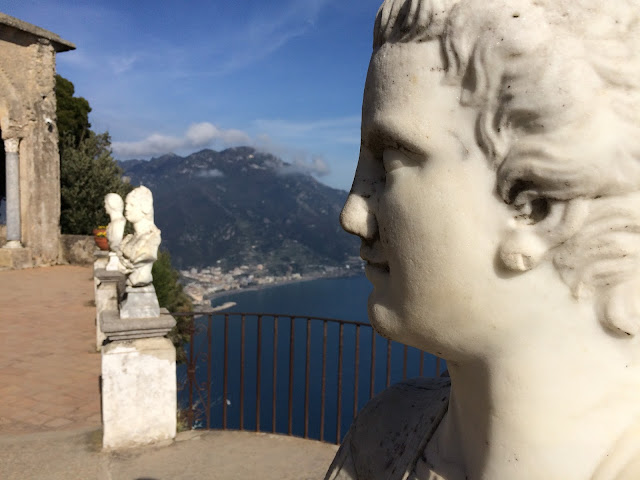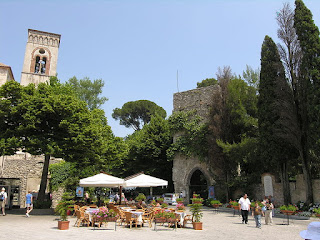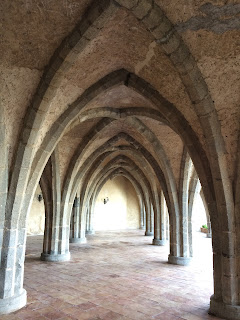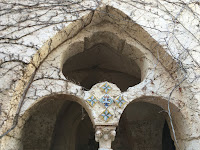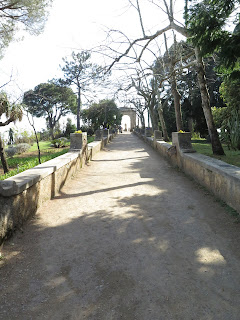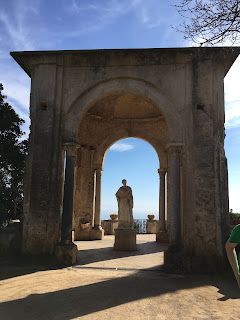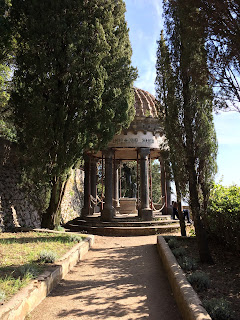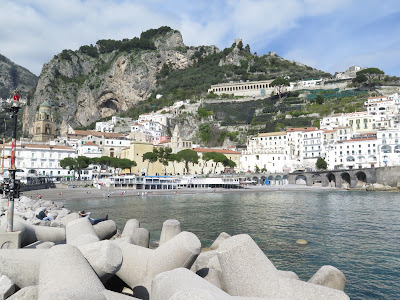Our last day in Italy came with such sadness; soon we would leave the warm lemon scented breezes and return to the harsh spring-time snow of South Western Ontario. Something about this trip to Italy has changed us; like we have stepped through a secret doorway. The change is liminal like a dream has just been born, yet so visceral we can see ourselves in this dream-future.To come up with an execution for our dream plan seems insurmountable at this point in our journey. But we will find the path...
Instead of having to return to Rome to fly home we booked our return flights to Gatwick from the Naples airport, which was convenient and not much more in cost. Our flight did not leave Naples until the late afternoon that day and we had lots of plans for things we could see and do, but truth be told: we were tired!
 We had to vacate our Sea Cottage in Marina Grande by 11:00 so we found a place to ditch our suitcases at the Sorrento "Ticket Point" kiosk at the train station. TIP #1: YOU CAN PAY A FLAT FEE PER BAG AND HAVE YOUR LUGGAGE STORED SECURELY AT THE SORRENTO TRAIN STATION. This was so great, it allowed us to walk around Sorrento to buy last-minute gifts,
We had to vacate our Sea Cottage in Marina Grande by 11:00 so we found a place to ditch our suitcases at the Sorrento "Ticket Point" kiosk at the train station. TIP #1: YOU CAN PAY A FLAT FEE PER BAG AND HAVE YOUR LUGGAGE STORED SECURELY AT THE SORRENTO TRAIN STATION. This was so great, it allowed us to walk around Sorrento to buy last-minute gifts, have a leisurely and substantial Italian lunch and of course, the last lemon gelato at Gelateria David by the Sorrento train station. The bus to the Naples airport conveniently departs from the Sorrento train station several times a day. The Naples airport was about an hour away by bus and we found it to be a lovely; modern, not too big airport with great transport connections to the rest of Southern Italy. The plane took off and we looked down to get one last bird's-eye view of the Bay of Naples and the crater of Mount Vesuvius.
Naples to Gatwick UK was quite a shock, leaving the sun and romance of Southern Italy for cold rain in England. We arrived at our airport hotel just in time to eat a dinner of pub burgers, a nice pint of stout for Luke and a glass of white wine from Italy, that actually made me melancholy as we reflected on our trip. The next morning our hotel provided a big English Fry breakfast, which was great because we were unprepared for Gatwick's food prices. TIP #2: GATWICK DEPARTURE LOUNGE IS SUPER EXPENSIVE! There were plenty of choices for restaurants or take out bars for food, but I have never seen higher airport prices than at Gatwick. It was cheaper to purchase food on the plane ride home! I should have put some hard boiled eggs in my purse from the breakfast buffet like my Mom used to! 😉
Spreading the return journey home from Italy to a two day overnight stop worked very well. Yes, we had to pay for a hotel room for Saturday night, but it allowed us to have all day Saturday enjoying Sorrento. Not having to get up at 4am to drag ourselves to a foreign airport for an early morning flight home (like the last time we went to Italy 4 years ago) was worth every penny. Also, when we arrived home on Sunday afternoon we did not experience any jet lag; everyone went about their normal work/school/rehearsal schedule. It was brilliant; as one may say in the UK.
Four years had passed since our last family trip to Italy and so much had changed for us; we moved from a big Oceanside city in Canada across the country to a quiet 150-year-old farm near a small village, my husband experienced the death of both his parents, and our only son has grown up to be a genuine teenager.
And we didn't lose a cell phone!
 Our second family journey to Italy was like a second date with a Soul Mate; we are getting to know Her better and more intimately. We visited two Countries (Vatican City IS a micro-country after all), seven UNESCO world heritage sites including three major Italian cities that are seats of power. We saw ancient wonders, urban jungles and rugged natural beauty that surpasses anything we've ever seen before. We have been to the top of live volcanos and gone into mysterious caves in the sea. We have made some new life-long friends and visited with old friends that are now as close as family to us. We ate, drank and danced our way through our travels to Southern Italy.
Our second family journey to Italy was like a second date with a Soul Mate; we are getting to know Her better and more intimately. We visited two Countries (Vatican City IS a micro-country after all), seven UNESCO world heritage sites including three major Italian cities that are seats of power. We saw ancient wonders, urban jungles and rugged natural beauty that surpasses anything we've ever seen before. We have been to the top of live volcanos and gone into mysterious caves in the sea. We have made some new life-long friends and visited with old friends that are now as close as family to us. We ate, drank and danced our way through our travels to Southern Italy.














